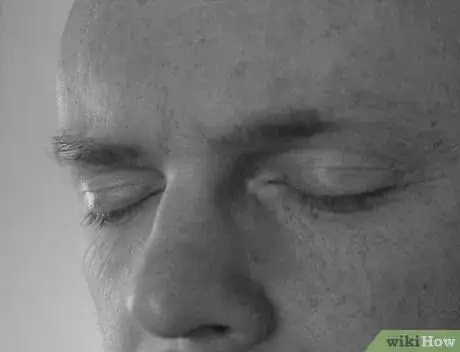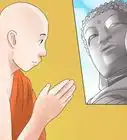Explore this Article
IN THIS ARTICLE
Other Sections
X
wikiHow is a “wiki,” similar to Wikipedia, which means that many of our articles are co-written by multiple authors. To create this article, 21 people, some anonymous, worked to edit and improve it over time.
This article has been viewed 87,142 times.
Learn more...
Mental freedom from your thoughts and feelings is a valuable skill to develop. Nothing is as wonderful and liberating as the ability to set the mind free and knowing that there are no longer any reasons to worry. While there are many ways to pursue this goal, we’ll focus here on the noble 8-fold path of the Buddha. Read on to learn everything you’d ever need to know about freeing your mind with Buddhism.
Steps
1
Understand that this takes time.
-
You’re unlikely to free your mind overnight, so adopt the right mindset. Freeing the mind is a really a continuous action that requires right understanding, right thought, right speech, right action, right effort, right livelihood, right mindfulness and right concentration. This is known as the eight-fold path and the word "right" is used as a term to denote skillful, or beneficial. Read through the list as follows and consider ways you can apply them to your own lifestyle as well as cases from your own experience where they can be of use.
- It's much like a recipe, with the right ingredients you get the desired result, but when the mix is wrong or misses out important parts it never really makes the mark. Many of the ingredients both support and interact with other parts supporting each other to make the completed goal.
- Another important point to consider is simply that there is right effort, by flipping it over implies that there is a wrong effort. This means simply that effort, mindfulness, concentration (etc) on their own are not enough. The Buddha's biography showed that he practice the 8 components in different forms, combinations and styles over time, but only when the application was right did they work together to give a solution.
Advertisement
2
Pursue understanding.
-
Consider the first of the 8 and how you can apply it. This is largely exploring and understanding in depth the 4 Noble Truths of Buddhism, but in essence right understanding is developing awareness that all things change. It is because they change without our consent we cannot ultimately depend on them, expect them to be perfect or to give us lasting happiness.
- Right understanding also understands the importance of being a virtuous person, practicing mental development and developing wisdom as these three aspects not only make up the 8 fold path, but also build and support each other.
3
Frame your thoughts.
-
Start to apply productive thoughts where you can. Right thought is encouraging thoughts of goodwill, understanding and non-greed, while abandoning greed, hatred and views, beliefs & delusions. Right thought needs right understanding to exist because without understanding, there is no basis of knowing the difference between skillful and unskillful thought chains.
- In a practical sense the four "divine abodes" of goodwill, compassion, appreciation and equanimity (or acceptance) are good for balancing the mind. The knowledge of the four noble truths may seem to make life dry, sterile and unhappy, where virtue as a support and applying the divine abodes will not only counter unhappy feelings, but create happiness and well-being. In practice when you feel cravings, consider appreciation of what you already have, when feeling unhappy, look at compassion. Its the use of opposites that make it so effective. Consider this basic analogy: in mathematics, (-1) + (1) = 0, in this sense a negative emotion can be balanced with a positive to balance the other out in order to regain well-being when it is practiced with sincerity.
Advertisement
4
Be mindful of your speech.
-
What you say to other people influences your mind. Speech actually follows from thoughts, when there are harsh thoughts, there is harsh speech, but when harsh thoughts are abandoned, harsh speech doesn't occur as it doesn't have the mental intention to be so. On the flip-side, when there is a positive mental state, a person can give more skillful and positive speech in a discussion.
- In a practical sense, it also includes times when it may be inappropriate to discuss certain issues, so right speech takes this into account as well as being virtuous speech.
5
Behave yourself.
-
Doing the right thing is a big part of being a complete person. This also follows from right thought in one sense because if we have thoughts of anger, it prompts action of the same theme. Right action & speech should be directed towards being harmless and letting go of stress.
- The interesting thing to notice is that right action is also letting go of things that cause stress in the mind. Right action builds and supports right thoughts and also right speech, because it is not enough to just think about abandoning something harmful or practicing something beneficial, you need to actually step in and do it. This is another key way that the path components engage and build other parts of the same path.
Advertisement
6
Put some effort in.
-
Freeing your mind can be hard work, so stick with it. Right effort is just applying effort to be aware and to do the jobs that are not easy to do. It is largely a middle ground focus, not an over-kill effort to force the mind or a violent effort to destroy aspects of it (which is a fruitless endeavor), nor is it its opposite - no effort. It's a middle ground effort with the intention to not cause harm.
- In a practical sense, right effort applies to all the other path components. Without effort there is no inclination to do skillful actions as its much easier to do nothing and let the mind run wild. But effort needs right understanding as its so easily misapplied and unbalanced.
7
Consider your lifestyle.
-
Your experiences and habits are a big part of who you are. Right livelihood is about avoiding going into a job where you have to be brutal and harsh towards people and other living or non-living things, or in any work that will compromise virtue, mental skills and wisdom. This is not always possible and it is the very lucky that have such jobs that are harmless and have choice in the kind of career they take.
- In a practical sense, right livelihood is not a livelihood that "owns" you or that you claim to own. If you have a good job, then right thought comes into play with valuing what you have when you bear in mind that there is still slave labor in parts of the world. When you are in a job that is less than desirable, if at the end of the day you can leave your work & troubles at the door of the office and let goof the stress it may cause you, then that is the minimum to work for. Right effort and right action is also relevant as right livelihood is being a virtuous employee who earns their wage and doesn't involve themselves in office politics or shirking their duties.
Advertisement
8
Practice mindfulness.
-
Monitoring your thoughts and feelings can help you free your mind. Mindfulness is the awareness of day-to-day activities as well as what's happening in the biological body and its feelings and the mind and mental feelings as and when they happen. Mindfulness is an ongoing activity that may involve mental noting, or just bare awareness and observation. But ideally involves right action and right understanding so when you see something, you know what to do with it and will do it. Just noting or watching does not remove the problem.
- If you cannot be aware of what's going on, then it is almost impossible to apply right action in abandoning stressful thoughts and harsh intentions. With mindfulness you can also recognize and learn to distinguish stress (which is developing insight) as well as potentially harmful thoughts and intentions. But mindfulness needs understanding and effort to do, so it also dependent on the practice of these components.
9
Stay focused.
-
Stick to the tasks you set your mind to. It can be in meditation or day to day activities. Without concentration, there is no effort or mindfulness. It is developed with time and right understanding, but also with right effort, without which concentration and mindfulness fall flat.
- In certain contexts, concentration is directly linked or limited to meditative absorption known as Jhana or Dhyana. Absorption is an excellent skill to develop but it must be remembered that in isolation it doesn't do the job. It can also cause many more complications such as addiction to that peaceful state, more delusions and even panic or despair that the peaceful state doesn't last, or that absorption is never attained even with much practice. It is the majority of people who will never experience it.
- Jhana can be used like a magnifying glass to see into the mind and is highly effective however this insight can also be done in non-absorption meditation, but only with lots of time and dedication observing the mind day in, day out. Its other key virtues are that it deeply calms the mind for extended periods that are not developed in non-absorption meditations as deeply or lasting as long, which is why insight meditation is often called dry, as it doesn't give deep lasting peace. It can also lead to higher mental developments which is another benefit, depending on right understanding. It should therefore be remembered that there are many who have attained the absorptions but still were not free of their problems, so it is a skill to develop but still a component. It needs right effort, right understanding and right mindfulness to develop.
- Interestingly, Buddha taught those who can do Jhana to praise and respect those who can't do Jhana as they need strength, diligence, commitment and very deep understanding to be able to put down the burden. Those who can't do Jhana were taught to respect and praise those who can because it is a very difficult skill and is not something everyone can do.
Advertisement
10
See the way things fit together.
-
Take a step back and look at the grand scheme of things. Take note of this group and consider how each section not only relates to each other but can be practiced for your own benefit. Many of them seem logical and common sense, but as always, the proof is in the pudding. The important thing to remember is by and large we always end up at right understanding as the key foundation component that all the others depend on because without understanding, the others aren't as effective.
11
Start small.
-
Start to incorporate little changes into your daily behavior. The biggest benefits are when you start to measure them against your own past and present experiences by experimenting to see if it makes a difference and comparing with past experiences. This not only increases the speed at which they begin working, but also makes them easier simply because you understand their benefit - right understanding again.
- Also take special care to note that there is no "right culture" or "right traditions, rites and rituals" in this group as they are really the "wallpaper" of life. It adds color and interest, but while its not only non-essential it can be a major disadvantage if handled unwisely. The main reason so many miss the mark is that they are still attached to culture and identity, teachers, lineage and interpretations of things without either being willing to let them go or actually examining if these attachments or things would ever have led to mental freedom in the first place.
- The Buddha put this in a simple analogy, after people have crossed the river, they don't carry the boat on their heads. Ultimately if you have crossed the river but are attached to staying in the boat on the other side, you haven't ever stepped off to continue your life's journey. These things can take you a long way, but you are standing still and going nowhere if you stay in the boat that has landed on the beach. By using mindfulness to recognize and understand things so you are no longer hoodwinked by our experiences and letting go of the ones of no value, you have set your mind free.
Advertisement
Community Q&A
-
QuestionI want to practice Jhana. Can you suggest some blogs?
 SmoothParrotCommunity AnswerLook up "wildmind.org -- how to get into Jhana." The first link that pops up should do the trick; the blog post was very informative.
SmoothParrotCommunity AnswerLook up "wildmind.org -- how to get into Jhana." The first link that pops up should do the trick; the blog post was very informative.
Advertisement
You Might Also Like

How to
Understand and Develop Insight

How to
Become a Buddhist

How to
Become a Buddhist Monk

How to
Become Enlightened
-Step-10-Version-3.webp)
How to
Reverse Bad Karma

How to
Be a Shaolin Monk

How to
Practice Non Attachment
How to
Make a Shamballa Bracelet

How to
Practice Buddhism

How to
Attain Nirvana

How to
Know What Creates Negative Karma

How to
Create a Simple Buddhist Shrine

How to
Become a Buddha

How to
Boost Your Karma
Advertisement
About This Article
wikiHow is a “wiki,” similar to Wikipedia, which means that many of our articles are co-written by multiple authors. To create this article, 21 people, some anonymous, worked to edit and improve it over time. This article has been viewed 87,142 times.
91 votes - 85%
Co-authors: 21
Updated: June 10, 2022
Views: 87,142
Categories: Buddhism
Advertisement























































